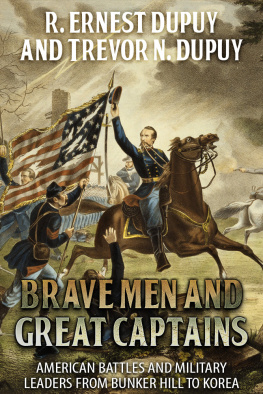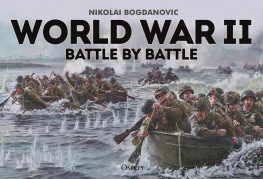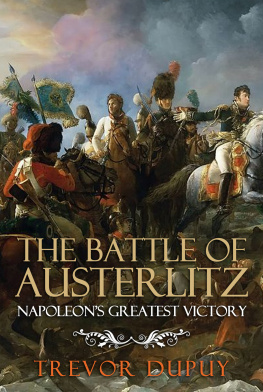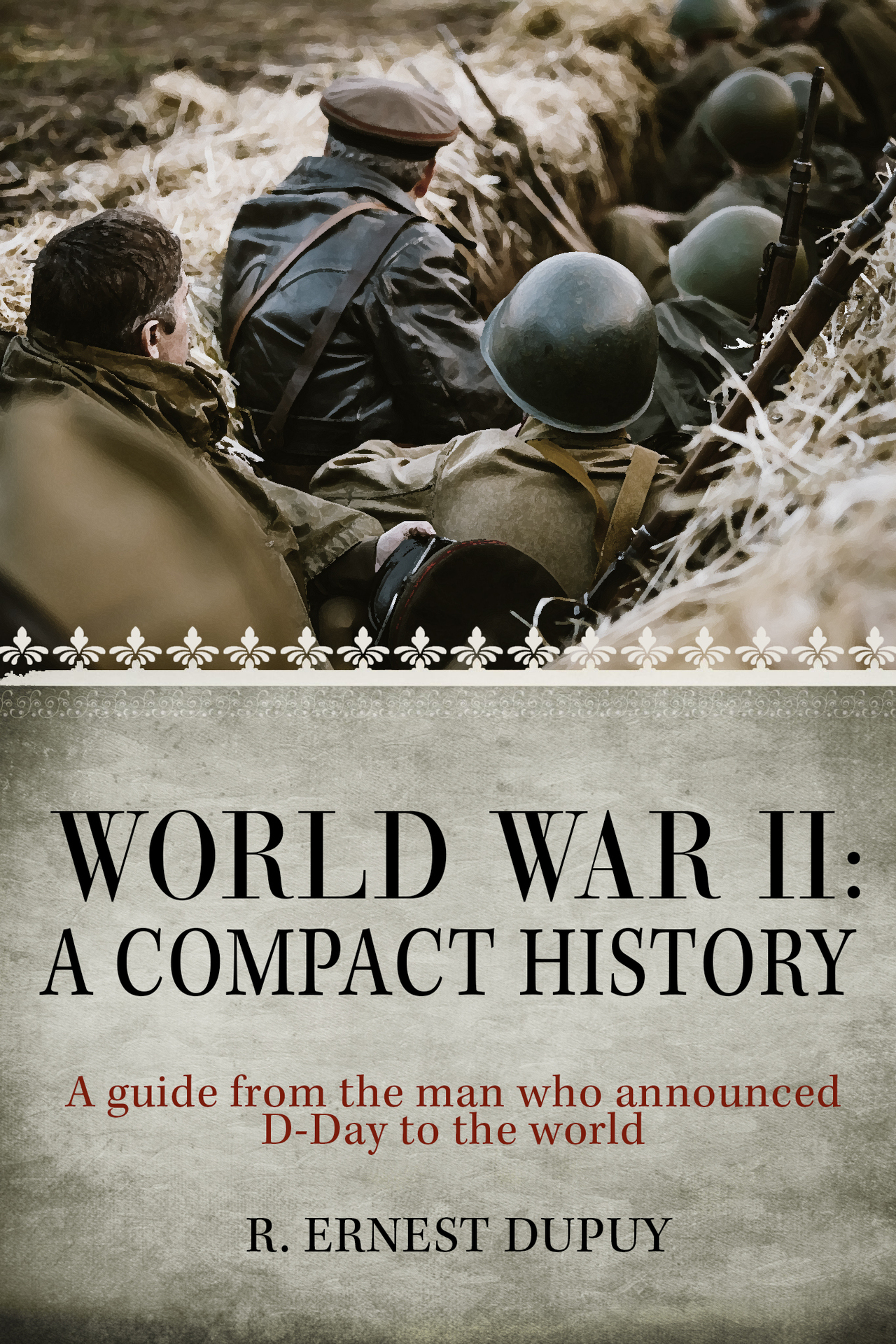WORLD WAR II: A COMPACT HISTORY
by Colonel R. Ernest Dupuy
.
Hawthorn Books, Inc. 1969
R Ernest Dupuy has asserted his rights under the Copyright, Design and Patents Act, 1988, to be identified as the author of this work.
First published in 1969 by Hawthorne Books, Inc.
This edition published in 2018 by Endeavour Media Ltd.
To Laura Nevitt Dupuy, tender in heart and indomitable in spirit.
Army wife and Army mother, she has bravely seen her men away to three of her countrys wars, including this one.
Table of Contents
Preface
T his compendium of the world-wide military operations in World War II is focused primarily upon the participation of the United States. Any presentation of the American effort in vacuo , however, would not only be manifestly unfair to the other Allies but would also present a warped narrative unfit to be classified as history.
Accordingly, the author has attempted to record the entire conflict, hoping so to orient the reader that he will be familiar with the outline of the vast picture while at the same time appreciating the decisive part played by the United States in the free worlds victory over the powers of totalitarianism.
Fifty-seven nations participated in the struggle. Some fifteen million fighting men died, and about thirty-eight million civilians of both sexes also perished. Among these latter were approximately six million Jewsmen, women and childrenmurdered by command of Adolf Hitler. In human life the war was twice as costly as was World War I; the economic and financial cost, some $1,600 billion, was five times the price of its predecessor.
Britains lion-hearted leader, Winston Churchill, after the war, summed up the American effort as a prodigy of organization, of improvisation, and confessed that he was mystified by this nations ability to find the leaders and vast staffs capable of handling enormous forces and of moving them faster and further than masses have ever been moved in war before.
It is manifestly beyond the scope of this book to relate in detail the methodology through which the United States accomplished its stupendous share in the task, how the men were obtained, trained and led, and how the matriel they used was invented, developed and produced in this country.
The question of who won the war has interested many people. The logical answer, it would seem, must be a paraphrase of Marshal Joffres response to a query as to who won the Battle of the Marne during World War I:
Who won? I dont know. But if we had been beaten, I know damn well who would have lost it!
Acknowledgments
Laura Nevitt Dupuy, as always, has been my inspiration and guide in this task.
Trevor N. Dupuy, through his careful reading of the manuscript and his deft professional suggestions, has placed me under a tremendous obligation.
The McGraw-Hill Book Company has graciously permitted the reproduction of the maps, which were originally published by it in Military Heritage of America (R. Ernest Dupuy and Trevor N. Dupuy).
The author is solely responsible for any errors or omissions of fact in this work. The opinions expressed and conclusions drawn are his alone, and may not be attributed either to the Department of Defense or to any of the services at large.
R. E rnest D upuy
Colonel, USA, Ret .
Arlington, Virginia, 1969
Prologue
D ragons teeth sown by the T reaty of V ersailles sprouted armed men in 1939. An Austrian ex-paperhanger, a Georgian cutthroat and an Italian gangster in uneasy alliance began to take the Western world apart. Over in the Far East a clique of fanatical Japanese militarists, taking advantage of the diversion, later joined, to pursue their own ends toward world domination.
Three sinister totalitarian ideologies were on the move: Nazism and its smaller, but equally nasty, elder brother Fascism; Marxian Communism; and the feudal imperialism of Nippon. Adolf Hitler, maniac of ferocious genius, the repository and expression of the most virulent hatreds that have ever corroded the human breast (that was Winston Churchills definition of the man), lighted the Third Reich down the devils garden path with an ignis fatuus of Lebensraum and anti-Semitism. Benito Mussolini fired a more docile Italy by a paler simulacrum. In the USSR Josef Stalin headed a Communist Party dedicated by Vladimir Lenin to world conquest. In the Far East, Japans Hideki Tojo sought control of the Southern Resources AreaBritish Malaya and the Netherlands East Indiesas the logistical reservoir for Japanese military power; this was the capstone for the Greater East Asia Co-Prosperity Sphere scheme, by which a divinity-directed Japan would finally rule the world. Seeing vast Communist Russia as a common foe and victim, Hitler, Mussolini and Tojo were linked in an Anti-Comintern Pact. Then, in late summer of 1939, the world was amazed to find Hitler and Stalin signing an alliance that was a clear prelude to a European war.
The aims of the respective totalitarian leaders were selfishly antagonistic. Accordingly, the so-called European and Pacific Axis was a wolf pack rather than an alliance, each member as ready to rip open a partners throat as to leap upon a common prey. This, as it turned out in the end, would be fortunate for the rest of the world and in particular for the United Statesinitially an onlooker. For, except for Italys Mussolini, who would take merely the jackals role, the other two Axis members were acting upon premeditated and long-calculated plans.
Three of the four totalitarian powers had formidable war machines with which they hoped to achieve their objectives. Insofar as the Third Reich was concerned, Hitlers plans were executed by professionals; competent military mensome of them brilliantbut, as it proved, often severely handicapped by their Fhrers intuition. Stalin and his Red Army made up in bulk what they lacked in professional competence; they would have to learn war the hard way, by trial and error, but learn they did. Japanese military and naval leadership was technically skillful and tactically competent; strategic weaknesses and a shortage of trained intermediate leaders were to prove critical; Japans greed for conquest would exceed its military digestive capability.
For two years the United States, on the sidelines, watched Europe sink. Our people saw the transient Hitler-Stalin alliance shatter early into strife. They mouthed imprecations at Nazi submarine-war atrocities, bewailed Japans blood lust in China, applauded the spectacle of Britain standing alone against the storm. But that was all.
The nation, recovering from the Great Depression, was beguiled by the rosy promises of an it cant happen here complex. It was deluged by pacifist propaganda emanating from both Nazi and Communist sources. Vocal minorities, each spouting its own brand of isolationist pacifism, rallied around the America First Committee, which, top-billing Charles Lindbergh, paraded, picketed, protested, and preached an amalgam of isolationism and pacifism, with overtones of anti-Semitism.... The Committee fought tooth and nail every move of President Roosevelt to better our global preparedness posture.
Roosevelts policy of assisting the Allies against Hitler by every means short of war was surprisingly successful, considering the limited and grudging support accorded him in the United States. As late as August 1941, renewal of the draft (Selective Service Act) passed the House of Representatives by but a one-vote majority. The President slowly strengthened our armed forces, put the thriving arms industry on a cash and carry basis, instituted Lend-Lease, traded Britain old destroyers for Atlantic bases, seized German shipping in US ports and froze German assets here. Boldly including Greenland and Iceland within the US sphere of influence in the Atlantic, he sent ships and soldiers there to emphasize his words. In August 1941, Roosevelt and Winston Churchill, Britains lionhearted prime minister, meeting at Argentia, Newfoundland, had agreed on and promulgated the Four Freedoms policy: freedom of speech and expression, freedom of worship, freedom from want, and freedom from fear. By September all pretense of US neutrality had gone by the board in the Atlantic. Nazi submarines had sunk American vessels; and Roosevelt, ordering the arming of our merchant marine, also ordered US warships on convoy duty to shoot all U-boats on sight.










